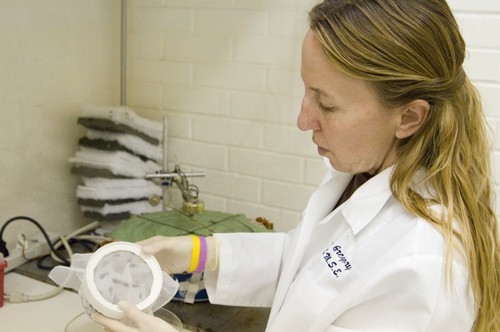“”Kissing bugs”” might not be as friendly as their name implies, new research at the UA suggests.
In 2005, Carolina Reisenman, associate staff scientist, Pablo Guerenstein and John Hildebrand, director of neurobiology, collaborated with the Centers for Disease Control and wrote a proposal — the Kissing Bug Project — funded by the Arizona Biomedical Research Commission.
Hildebrand, the principal investigator for the project, who does the laboratory and field work, said, “”kissing bugs are important in southern Arizona because they bite humans to get blood-meals — their bites are allergenic and some people have very bad allergic reactions to the bites.””
The researchers were originally seeking an explanation as to why the bugs bite humans instead of or in addition to “”their usual hosts for blood-meals,”” Hildebrand said.
He added that in the course of the research, the team discovered that a high percentage of the local kissing bugs are carrying the parasite that causes Chagas disease, an illness spread by insects, most common in South America and more recently in Mexico.
“”We also study kissing bugs from South America. In that research project we are trying to learn about odors that attract the kissing bugs and trying to develop trapping strategies that could be used to intercept the insects before they enter people’s houses,”” Hildebrand said.
A possible strategy is the use of detection and control tools — which might reduce triatomine (the scientific name for the family to which the bugs belong)-human contact and the risk to human health, Reisenman said.
“”For instance, traps which are baited with odors that attract kissing bugs can be an effective method,”” she said. “”The idea is to divert insects from invading human houses.””
These bugs, abundant in southern Arizona, get their name because they usually bite people near their mouth during the night while they sleep, according to the neuroscience department’s Web site. It states that kissing bugs are blood-suckers, similar to mosquitoes, ticks and tsetse flies.
They are attracted to the odors that people exhale, and the face is usually the only exposed area of skin during sleep.
Arizona is the state with the highest number of triatomine-human contacts reported in the United States, Reisenman said.
She added that health problems related to triatomines in Arizona will become more common, now that more people are choosing to live in triatomine habitats.
The team collected about 500 insects in 2007, 800 in 2008 and about 500 in 2009, she said.
The parasite is transmitted when feces and urine from infected bugs come in contact with damaged skin, eye mucous membranes, or when the victim rubs the itchy wound site, Reisenman said.
“”Because the bug’s bite is painless and occurs at night, most people never know they have been bitten, but some experience severe allergic reactions,”” she said.
However, currently the research is at a halt, because the researchers do not know if they can secure funding from the Arizona Biomedical Research Commission, she said.
Reisenman said the project started in 2006 and ended last July.
“”We applied for funding to continue these studies, but we don’t know the outcome yet. Since we currently do not have funding, the project is on hold, although we still have some papers to publish,”” Reisenman said.









